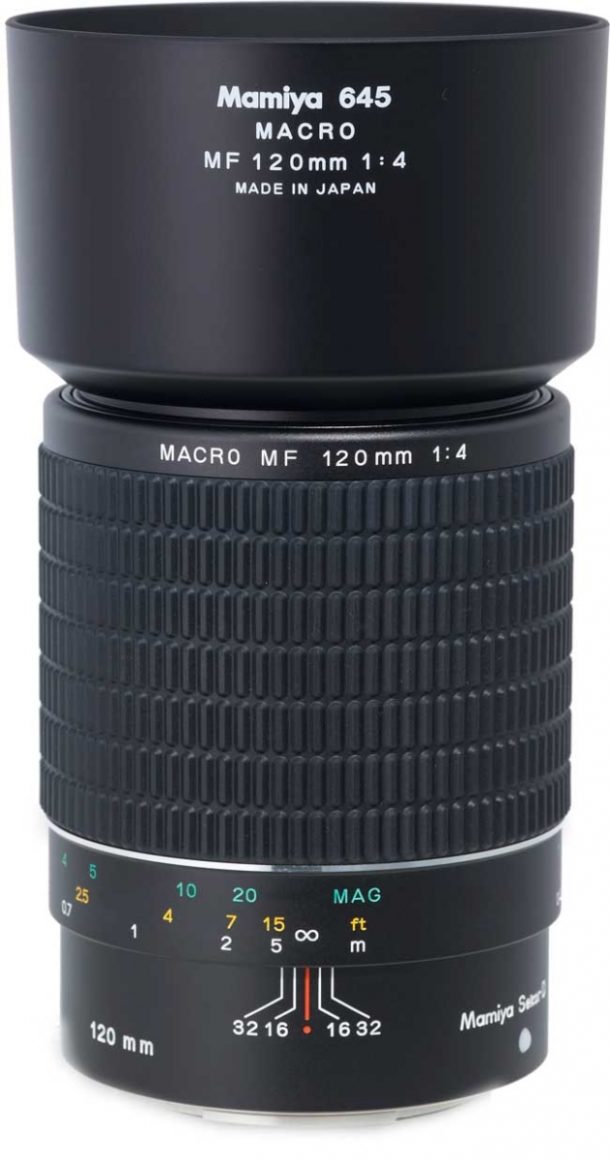Mamiya Sekor D MF 120mm F/4 Macro
Macro lens • Digital era • Discontinued
- Announced:
- · January 2008
- Production status:
- ● Discontinued
- Country of design:
- · Japan
- Original name:
- · Mamiya Sekor D MACRO MF 120mm F/4
- Class:
- · Slow 6x4.5 medium-format macro lens
- · Professional model (Top class)
- System:
- · Mamiya M645 (1975)
Abbreviations
| MACRO | Macro lens. Designed specially for shooting close-ups of small subjects but can be also used in other genres of photography, not necessarily requiring focusing at close distances. Learn more |
Model history (4)
| ■Mamiya A 120mm F/4 Macro M • 1:1 | A | 9 - 8 | 0.40m | ⌀67 | ● | |
| ■Mamiya 645 MF 120mm F/4 Macro • 1:1 | A | 9 - 8 | 0.40m | ⌀67 | 2000 ● | |
| ■Mamiya Sekor D MF 120mm F/4 Macro • 1:1 | A | 9 - 8 | 0.40m | ⌀67 | 2008 ● | |
| ■Mamiya Sekor D AF 120mm F/4 Macro • 1:1 | A | 9 - 8 | 0.37m | ⌀67 | 2011 ● | |
Specification
| Optical design: | |
| Medium format 6x4.5 | |
| 120mm | |
| F/4 | |
| 9 elements in 8 groups | |
| Floating element system | |
| Mamiya M645 [63mm] | |
| 32.4° | |
| Diaphragm mechanism: | |
Diaphragm type: | Automatic |
Aperture control: | None; the aperture is controlled from the camera |
| <No data> | |
| Focusing: | |
| 0.40m | |
| 1:1 | |
Focusing modes: | Manual focus only |
Manual focus control: | Focusing ring |
| Physical characteristics: | |
| 845g | |
| ⌀83×111mm | |
| - | |
| - | |
| Accessories: | |
| Screw-type 67mm | |
| Bayonet-type round | |
| Not available |
Sources of data
- Manufacturer's technical data.
- 645AF interchangeable lenses instructions (II).
- Mamiya 645AFD III booklet.
Manufacturer description #1
Elmsford NY, January 10, 2008 — Mamiya has introduced the new Mamiya Sekor Macro MF 120mm f/4 D Lens — successor to the popular Mamiya Macro MF 120mm f/4 Lens.
"The Mamiya 120mm f/4 macro lens is one of the sharpest lenses available today," said Jeff Karp, Mamiya Product Marketing Manager, "and it has already been critically corrected for digital imaging. But it needed an upgrade to be fully compatible with the latest cameras, software and digital backs."
The primary upgrade of the new lens is related to digital communication with the camera. Data transfer is now controlled by a 16-bit CPU instead of the previous 4-bit CPU.
The advantages of the new CPU are:
- Rewritability: The new 16-bit CPU is rewritable and can be overwritten with firmware upgrades that would be required for compatibility with future cameras and digital backs.
- Finer Lens Correction: Thanks to the bigger capacity of the CPU, the new lens has more lens data. It is possible to apply finer lens-characteristic corrections when using Mamiya's Digital Photostudio® software.
- Fast, Reliable Communication: The new CPU enables faster and more reliable communication with the camera body.
As its name suggests, the new D-series lens shows it's true capabilities when shooting with the Mamiya ZD Digital back and other high-end digital backs. However, it is designed to be equally at home with film backs.
The new Mamiya Sekor Macro MF 120mm f/4 D Lens is compatible with the Mamiya 645AFD ll camera and is available for immediate delivery.
Manufacturer description #2
With an angle of view of 33 degrees, this macro lens offers the perspective of a 73mm focal length in the 35mm format. This manual focus lens is capable of photography from infinity to 1:1 magnification. Its anomalous dispersion glass allows for correction of color aberration and captures images of supreme color balance, high contrast and resolution. Also, when employed with the Mamiya ZD/645AFDIII, use is optimized via a 16 bit CPU.
Other macro lenses in the Mamiya M645 system
| ■Mamiya M645 mount (4) | |||||||||
| Mamiya-Sekor C 80mm F/4 Macro N • 1:2 | A | 6 - 4 | 0.36m | ⌀67 | ● | ||||
| Mamiya-Sekor C 80mm F/4 Macro • 1:2 | A | 6 - 4 | 0.38m | ⌀67 | 1977 ● | ||||
| Mamiya A 120mm F/4 Macro M • 1:1 | A | 9 - 8 | 0.40m | ⌀67 | ● | ||||
| Mamiya 645 MF 120mm F/4 Macro • 1:1 | A | 9 - 8 | 0.40m | ⌀67 | 2000 ● | ||||
